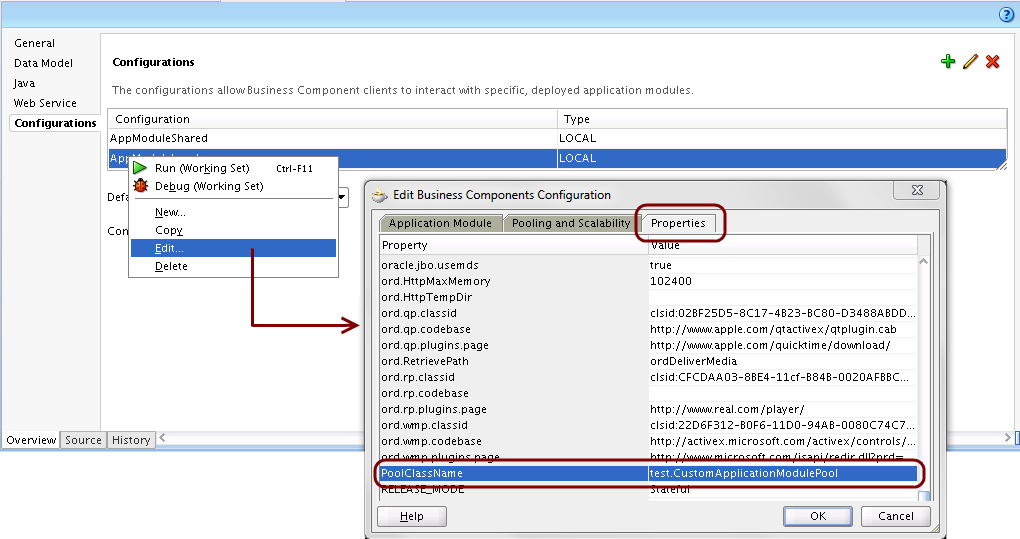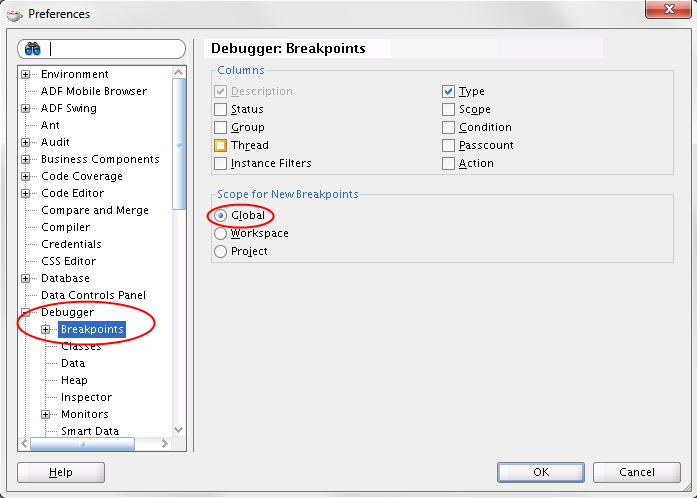Tracking Application Module Pool operations
To get a better understanding how the Application Module Pool works in Oracle ADF, it can be useful to log some of its methods as they are called. This can also be useful to track down Application Module Pool related issues, or even to collect usage and performance statistics. The entry point for such a logging facility is to define a custom Application Module Pool class. Note that this is not something you would or should do in the final application – it is usually not necessary, but can be convenient for the use cases mentioned above. The class to instantiate as the Application Module Pool is defined through the PoolClassName property on the Application Module’s configuration:

The configuration is stored in the bc4j.xml configuration file, and we could also set the property by simply editing this file:
<appmoduleconfig deployplatform="LOCAL" jdbcname="ApplicationDB" jbo.project="model.Model" name="AppModuleLocal" applicationname="model.AppModule">
<am-pooling poolclassname="test.CustomApplicationModulePool">
<database jbo.locking.mode="optimistic">
<security appmodulejndiname="model.AppModule">
</security></database></am-pooling></appmoduleconfig>
Now, the ADF runtime will instantiate an object of the defined class as the Application Module’s pool. We simply need to implement this class, inheriting from ApplicationPoolImpl:
package test;
import java.util.Properties;
import oracle.jbo.ApplicationModule;
import oracle.jbo.common.ampool.ApplicationPoolImpl;
import oracle.jbo.common.ampool.SessionCookie;
public class CustomApplicationModulePool extends ApplicationPoolImpl {
public CustomApplicationModulePool() {
super();
}
...
}
By overriding the methods which are of interest, we can add logging to the application module pool and for example track how Application Modules are checked out and released. Ideally a logging API such as java.util.logging should be used – for simplicity, I am using System.err in the examples. The most interesting methods to track Application Module usage are useApplicationModule() which is called by the framework to check out an application module from the pool, releaseApplicationModule() which is called to give back an application module to the pool and probably createSessionCookie() which creates a session cookie for a BC4J session:
@Override
public SessionCookie createSessionCookie(String applicationId,
String sessionId,
Properties properties) {
System.err.printf("createSessionCookie(applicationId=%s, sessionId=%s, properties=%s)\n",
applicationId, sessionId, properties);
SessionCookie result = super.createSessionCookie(applicationId, sessionId, properties);
System.err.printf(" Result: %s\n", result.getSessionId());
return result;
}
@Override
public ApplicationModule useApplicationModule(final SessionCookie cookie,
final boolean checkout) {
System.err.printf("useApplicationModule(session id=%s, checkout=%s)\n",
cookie.getSessionId(), checkout);
ApplicationModule result = super.useApplicationModule(cookie, checkout);
System.err.printf(" Result: %s\n", System.identityHashCode(result));
return result;
}
@Override
public void releaseApplicationModule(SessionCookie cookie,
boolean manageState) {
System.err.printf("releaseApplicationModule(cookie=%s, manageState=%s)\n",
cookie, manageState);
super.releaseApplicationModule(cookie, manageState);
}
@Override
public void releaseApplicationModule(SessionCookie cookie,
int releaseFlags) {
System.err.printf("releaseApplicationModule(cookie=%s, releaseFlags=%s)\n",
cookie, releaseFlags);
super.releaseApplicationModule(cookie, releaseFlags);
}
We can now observe how and when the ADF runtime retrieves Application Modules form the pool. Remember that each HTTP request which requires BC4J will result in an Application Module checkout and a corresponding release before the request finishes. Also remember that each Application Module has its own database transaction (unless it is a nested Application Module, in which case it inherits the transaction from its parent). Hence, logging information about the associated database transaction can also be useful.
